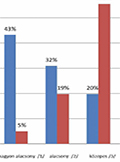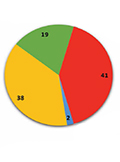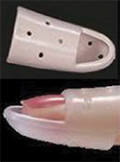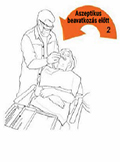The eLitMed.hu medical portal uses computer cookies for convenient operation. Detailed information can be found in the Cookie-policy.
Journal of Nursing Theory and Practice - 2017;30(05)
Content
[Importance of the Hyponatraemia in the Emergency Care]
[The aim of the study: Hyponatraemia is the most common electrolyte abnormality in hospitalized patients. Certain drugs (eg, diuretics, antidepressants, and antiepileptics) have been implicated as established causes of either asymptomatic or symptomatic hyponatraemia. Studies proved correlation between hyponatremia and hospital mortality. Hyponatraemia remains asymptomatic in most cases, but if left untreated, it can cause life-threatening situations. Our aim was to examine the frequency of hyponatraemia in our hospital and its impact on the emergency care. Methods: A total of 75 patients were enrolled in the study with purposive sampling. We used descriptive and mathematical statistics with SPSS 22.0 software package for processing non-parametric statistical data. Results: Patients transferred by ambulance or arriving at the ER department came with dizziness, vomiting / diarrhea symptoms. Admission causes, were characteristic symptoms of hyponatraemia as well as non-specific neurological symptoms (headache, dizziness, confusion, unconsciousness) were found (n = 29). In addition, a common complaint of vomiting / diarrhea (n = 12), abdominal pain (n = 10). In particular, the complaint leading to a significant proportion of patients with hyponatraemia was not typical, but it was kind of trauma (n = 12). Nearly half of the patients (n = 36) were revenant. The most common diagnosis was hypertension (34%). 52% were taking medication that typically cause hyponatraemia. There were significant increase in the incidence of hyponatraemia in cases where the patient was taking diuretics. Conclusions: The diagnosis of hyponatraemia is based on the recording history, physical examination, and laboratory tests. Preventive approach would reduce the number of hospital stays due to hyponatraemia, and this may indeed improve patients’ life expectancy. The disease itself is easily remedied, it can cause critical condition due to disregard.]
[The Prastige and Values of Nurses and Caregivers employed in the Social Service System]
[Aim of the study: During the study my target was to identify the career motivations, prestige of caretakers and nurses working in the Gödöllő social services and get acquainted with the most important values in their life. Sample and methods: Descriptive type research, number of elements are 81 (n=81). Summarization of the data was executed by Microsoft Office Excel 2007. Results: The employees took part in the research considered their profession as relatively low prestigious, although they would choose again this profession if they could decide again. Supporting professionals consider health, family, friendship and affection as the most important value in their life. Conclusions: The nursesand caretakers interviewed by me consider their choice of career successful in spite of its low prestige and they like their profession. Recognition the values of the employees is an important objective, because the identified values determine the quality of the work they perform.]
[Health Assessment of Taxi Drivers in the city of Miskolc]
[The aim of the study: The authors’ objective was to reveal the state of health and lifestyle of taxi drivers. Methods: The cross-sectional survey was conducted in 2017 among taxi drivers in Miskolc (N=100), selected using a random, sampling method. The data gathering took place using paper-based, anonymous, self-completion questionnaire. The proprietary questionnaire used was based on the questionnaire used in the National Population Health Survey (OLEF) for the standard survey of health behaviour. The authors analysed the gathered data with Microsoft Excel Excel 2016, using a descriptive statistical method. Results: The average health value of taxi drivers was 3.39 on a scale of five grades. 79% of the drivers are overweight or obese. 56% have a chronic disease affecting one or more organ systems. Examining their state of health based on the psychosomatic symptoms scale, the respondents most frequently indicated back and lumbal pain, and sleep disorders. The Epworth somnolence scale caused by 8% slightly abnormal sleeping disorder. To filter OSAS study-aid by the responders 34% was the test positive. Conclusions: The results of survey revealed that the health condition of respondents is unsatisfying. Based on the results they can state, that taxi drivers health is worse in many ways than an average Hungarian adult. On the whole it can be concluded that health behavior of taxi drivers needs to be changed. ]
[Post-operative external Fixation in Adult and Pediatric Hand Surgery from a Nurse’s perspective]
[Performing postoperative nursing duties on hand surgical patients is a special field of nursing. Our goal is to demonstrate what special - observational and other - duties are rquired of an adult/pediatric hand surgical nurse.We also would like to broaden the knowledge of our nursing staff, because due to our shortage of workstaff we are often forced into substituting positions, and patient safety requires us to be practiced in this field. We will give an overview of the most common fixating techniques, post-operative nursing duties and most common complications.]
[Hand Disinfection: the simplest method for preventing Nosocomial Infections]
[It’s quintessential that health workers have primary role in the development of the healthcare associated infections. Personal hygiene always had a different role. In Hungary hand disinfection became important thanks to Ignac Semmelweis. The nurse-training became a national matter so the related education became unified. The National Public Health and Medical Officer Service’s Methodological Letter describes the detailed regulation of hand disinfection. The compliance is mandatory to every health worker. It’s strictly regulates how the health workers has to disinfect their hand and regulates which tool has to be used for hand disinfection and how they should take care of their hand. Researches were trying to disclose the reason of the neglection of hand disinfection. The literature says tackling the issue is a long proccess. Thus everyone has a role in the change, but the health workers has the biggest and most important role in it.]
1.
Clinical Neuroscience
[Headache registry in Szeged: Experiences regarding to migraine patients]2.
Clinical Neuroscience
[The new target population of stroke awareness campaign: Kindergarten students ]3.
Clinical Neuroscience
Is there any difference in mortality rates of atrial fibrillation detected before or after ischemic stroke?4.
Clinical Neuroscience
Factors influencing the level of stigma in Parkinson’s disease in western Turkey5.
Clinical Neuroscience
[The effects of demographic and clinical factors on the severity of poststroke aphasia]1.
2.
Clinical Oncology
[Pancreatic cancer: ESMO Clinical Practice Guideline for diagnosis, treatment and follow-up]3.
Clinical Oncology
[Pharmacovigilance landscape – Lessons from the past and opportunities for future]4.
5.









